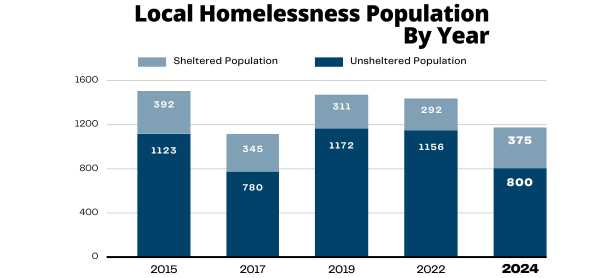Every two years, communities across the country conduct comprehensive counts of individuals experiencing homelessness in order to measure the prevalence of homelessness in each local Continuum of Care. The U.S. Department of Housing and Urban Development dictates the Point-in-Time Count’s methodology and timing to achieve nationwide consistency.
Questions regarding the Point-in-Time Count for the San Luis Obispo Community can be directed to project lead: Kari Howell, HMIS Program Manager at khowell@co.slo.ca.us.
2024 Countywide Point-in-Time Count
The 2024 San Luis Obispo County Point-in-Time Count was conducted on Tuesday, January 23, 2024. The final date for data collection was Wednesday, January 31, 2024, as allowed for HUD compliance.
Community Report
The 2024 San Luis Obispo Community Report on the findings of the Point-in-Time Count is now available. Click the button below to read the full report.
Read the Full Community Report
The County of San Luis Obispo has released its 2024 San Luis Obispo Community Report on the findings of the 2024 Point-in-Time Count, the communitywide census of all those experiencing homelessness on a single night. On the night of January 22, 2024, there were 1,175 individuals identified experiencing homelessness in San Luis Obispo County, a 19% reduction in local homelessness on a single night compared to the Point-in-Time Count conducted in 2022.
 Download the one-page version of the Community Report infographic here
Download the one-page version of the Community Report infographic here
You can get a summary of key stats from the Community Report by reading our quick, simple
one-pager for the 2024 PIT Count Community Report.
Volunteer Training Details
All volunteers completed a 2-hour training, offered both in-person and virtually, prior to the PIT Count. Training will provide volunteers with a sample script for administering the survey, safety best practices, emergency contact information, and directions for utilizing the mobile app on the day of the count.
Training Schedule
| LOCATION |
DATE |
TIME |
| San Luis Obispo |
Tuesday, January 9th, 2024 |
3PM-5PM |
| San Luis Obispo |
Thursday, January 11th, 2024 |
6PM-8PM |
| Virtual - Zoom |
Saturday, January 13th, 2024 |
10AM-12PM |
PIT Count Committee
Homeless Service Providers, nonprofit personnel, people with lived experience with unsheltered homelessness were invited to join the PIT Count Committee to lead the implementation and planning of the Point-in-Time Count. Responsibilities of the PIT Count Committee and historical meeting notes can be found in the PIT Count Committee page.
Volunteer and Stakeholder Recognition
Thank you to the hundreds of volunteers who gave their time and enthusiasm to meet the needs of the 2024 Point-in-Time Count. Thank you to the city and government personnel for their cooperation and support county-wide. Thank you to the PIT Count Committee members for their expertise in the planning and implementation process.
The time and support all volunteers and stakeholders provided contributed greatly to the success of 2024 Point-in-Time Count.
As required by HUD, the County of San Luis Obispo will conduct a Point-in-Time Count again in January 2026.
Frequently Asked Questions
The Point-in-Time Count, or PIT Count, is a comprehensive census of people experiencing homelessness on a single night. PIT Counts are required by the US Department of Housing and Urban Development (HUD) and are conducted every two years during the last 10 days of January.
The PIT Count is comprised of two parts:
- A census of people who are experiencing sheltered and unsheltered homelessness on a single night, and
- A multi-question survey of those experiencing unsheltered homelessness about their demographics and circumstances.
When and how does the County conduct a PIT Count?
The 2024 PIT Count was conducted on Tuesday, January 23, 2024, and continued through Wednesday January 31, 2024, and captured demographic data on people experiencing homelessness in San Luis Obispo County. The PIT Count included more than 250 volunteers deploying from seven logistic centers countywide. The PIT Count represents a collaborative effort involving dedicated volunteers, government agencies, non-profit organizations, and individuals experiencing homelessness who came together to assess homelessness in our community on a single night. Through their efforts, valuable data was gathered that will assist the county and community in understanding the needs of individuals experiencing homelessness.
What does data from the PIT Count indicate?
2024 PIT Count data shows a 19% reduction in homelessness in San Luis Obispo County based on the data captured. Increasing sheltered inventory alongside decreasing unsheltered homelessness county-wide is an encouraging trend reflecting a growing system of care. A complete analysis of homelessness in any community won’t come from one initiative alone, and yet PIT Count data is promising as the County continues to expand service provision, community partnerships, and pathways to housing. The overall picture of homelessness in any community is informed by both the information learned during a PIT Count and a balanced review of data continued within the Homeless Management Information System (HMIS). The San Luis Obispo Continuum of Care migrated to a new HMIS database on March 4, 2024.
Why the change in methodology from previous years?
The 2022 Point-In-Time Count was conducted using a sample survey methodology in which only a subset of the population is surveyed, and that sample is used to represent the entire population under study. In the 2024 Point-in-Time Count, a full census was completed with a focus on completing surveys with as many individuals as possible. This preferred methodology increased the reliability of the data collected. With this change, the number of individuals surveyed increased from 29% in 2022 to 64% in 2024. Surveys are only completed on unsheltered individuals. Of the 800 identified individuals experiencing unsheltered homelessness, 513 were surveyed.
How was location determined for everyone counted?
For the PIT Count initiative, the location for an individual experiencing homelessness was determined by the location the survey was administered. The data verification process for determining location was completed in three specific ways:
- By the app Survey instrument which utilized ArcGIS mapping software and collected GIS coordinates for the location captured when a survey was submitted;
- Surveyors had the opportunity to ‘write in’ the location of the individual, whether they were counted via observation or survey; and
- Cross-referencing the surveyor assignment, which would include the assigned logistics center and census map.
In some coastal and densely urban areas, the GIS mapping software assigned a location that did not align with county jurisdiction. Through the data verification process, including the location verification process, all individuals counted had their proposed locations verified and confirmed. As the focus was to survey as many unsheltered individuals as possible, surveys were administered at area access centers and service locations (such as CAPSLO's 40 Prado, 5CHC's 4th Street Navigation Center and South County People's Kitchen) where high numbers of people were utilizing services. Surveying at these locations facilitated the completion of a higher number of surveys. .
Why did some Cities show an increase in homelessness while the County overall showed a decrease? How should we interpret this data?
The PIT Count is a single measure of homelessness taken on one night and cannot be used to measure homelessness overall in any community. While the overall decline is encouraging, looking at any one location’s increase should not be perceived as an increase in homelessness in that particular location. As noted above, with the focus being on completing surveys so that an accurate count could be conducted, locations that had a service location where individuals experiencing homeless could receive services such as meals or case management would naturally lead to a higher number of individuals being counted in that location. That does not mean that is the location they typically reside in. Additionally, some jurisdictions had a larger number of service providers and/or volunteers conducting the count which may also have led to more people being counted in that location. The takeaway here is that having service locations encourages individuals experiencing homelessness to engage with service providers which in turn leads to a reduction of the number of people experiencing homelessness.
What was the data verification process, including how were duplicate surveys determined?
Each survey and observation submitted through the survey app or via paper survey was verified by the team at Thurmond Consulting, LLC, the Homeless Services Division, and technical assistance provided by the US Department of Housing and Urban Development (HUD). Data sets were cross referenced by unique client data and surveyor information and location to determine duplicate surveys. There were more than 150 duplicate surveys determined in the verification process illustrating the volunteers were capturing surveys as people may have moved during the day or days ensuring expansive geographic coverage.
Why was there a change in figures presented in the preliminary data release compared to the 2024 Report?
There was a data set released to the public on May 6 prior to a completed HUD verification with the knowledge that the federal verification process could change the final numbers by an amount fewer than 10 people overall. While not insignificant, confidence in the data set remained and trends were already evident.
How is information learned from the PIT Count implemented?
Information is shared with homeless service providers, government personnel, and city jurisdiction to inform priorities and funding opportunities.
How is the PIT Count information reported?
Data from the PIT Count is directly reported to HUD and nationwide PIT Count data is compiled to create the congressional Annual Homelessness Assessment Report. Regionally, information from the PIT Count is included in performance measures reported to California Interagency Council on Homelessness (Cal-ICH).

